

Ajay Subramanian - NanoJapan 2015
Rice University
Major: Materials Science & Nano Engineering
Class Standing: Freshman
Anticipated Graduation: May 2019
NanoJapan Research Lab: Prof. Yuichiro Kato, University of Tokyo
NanoJapan Research Project: Eliminating Gate-Voltage Hysteresis in suspended Single-Wall Carbon Nanotube Field-Effect Transistors ![]()

Why NanoJapan?
NanoJapan represents the perfect opportunity for undergraduates to immerse themselves in an area of cutting-edge research and also develop new perspectives as global citizens. For science and engineering students around the country, NanoJapan enables hands-on, direct work experience in an international setting. This means that students will not only be able tackle important issues like language barriers and teamwork, but also learn more about Japanese culture and society. And even beyond personal benefits, I think the problems that STEM fields attempt to tackle are universal. It is essential that we fledgling problem-solvers collaborate universally. Besides, who wouldn’t want to work in arguably the current science and technology mecca of the world?
I chose to apply to NanoJapan both for the reasons above and because of my interest in Japan itself. I have a passion for travel and adventure, and having the opportunity to take an adventure to Japan is something I could not pass up. I am most excited for two major things. First is the actual research I will be doing. As a Materials Engineering major, I am excited working on terahertz nanostructures, a relatively new field especially when related to device fabrication or new material synthesis. My hope is that the research I do will help me decide in which areas in my field I am most passionate so I can move forward with a focus throughout my undergraduate studies. I am also excited to learn Japanese as I am a complete novice!
My goals for this summer are to:
Research Project Overview & Life in the Lab
Eliminating Gate-Voltage Hysteresis in suspended Single-Wall Carbon Nanotube Field-Effect Transistors ![]()
Single-wall carbon nanotubes (SWCNTs) have an immense potential to revolutionized modern day electronics and optoelectronics due to their unique optical and electronic properties. Particularly, semiconducting SWCNTs have a direct band-gap, allowing one to take advantage of both optical and electronic properties in a device. One such device is the SWCNT field-effect transistor (FET). However, SWCNT FETs exhibit gate-voltage induced hysteresis and time-dependent behavior. This hysteresis, likely caused by atmospheric and environmental effects, prevents one from truly ascertaining the gate-dependence on multiple properties of the device. Our goal is to eliminate this hysteresis, figure out the conditions for doing so, and analyze the SWCNT FET devices without the hysteretic behavior.
As a Materials Engineering student that’s interested in electronic materials, this project is super relevant to my future studies. Nanocarbons in general hold an immense potential to revolutionize our electronics and tech industries. I had a good experience working in an international setting. Although it was challenging to break through some cultural barriers (like language), I was able to become good friends with my lab mates and have a successful project. I’m definitely leaning towards graduate school because of this program.
My lab situation was a bit different from the more traditional, hierarchical structure of Japanese research labs. We had flexible schedules, alerted each other when they will be absent or sick, and worked hard on their projects when we were in. We have a group Google calendar (like most labs nowadays), and an organizational whiteboard-magnet-wall for everyone to utilize to stay organized. We aren’t without fun though, as the baseball fans in the group have some gloves and balls to toss around when they aren’t busy. Plus, our student office area functions as a kitchen and people often cook (in situ). It’s a fun environment where I felt both comfortable and productive. My mentor, Takushi, and I had a great relationship. As i mention in my weekly reports (see below), Takushi was a great mentor as he helped developed my work timeline and aided me with any questions I had about equipment and science. Takushi, I, and the rest of the lab also were able to hang out outside of the lab quite a bit. My favorite highlight was going out to the Akihabara batting cages!
My daily life in Japan was quite simple. I would wake up sometime between 9:00AM and 11:00AM, shower, and head off to Morishita station for my commute to the University of Tokyo. The commute was about 30 minutes a day of subway-ing and walking. I would arrive onto the Asano campus and get right to work. I usually would grab lunch with some of my labmates in the U. Tokyo cafeteria (there were vegetarian options!) and then get back to work. Then, in the evening, I would either eat nearby, buy food to cook, or go travel. Usually, when I traveled, I would meet up with other NJ interns that were in the Tokyo area and head to Shibuya or Azabu-juban for dinner. After dinner, I’d head back to my small apartment and head to bed (or watch Netflix…)
After the first couple of days, my routine became pretty standard. I would sometimes make casual conversation (to the best of my ability) with the cafeteria workers who always seemed amused by my obsession with yasai kuroke or really yummy veggie cutlets. Every so often, on the weekends, I’d travel away from Tokyo (usually with other NJ’ers) and explore some of the fascinating, touristy things about Japan.
My favorite experience in Japan was… climbing Mt. Fuji after 3 months of NanoJapan-ing. The perfect culmination of an amazing summer with amazing people
Before I left for Japan I wish I had…studied up on reading kana and kanji more
While I was in Japan I wish I had…traveled a bit more (money and time constraints L)
It’s hard to believe it’s already been a week since we arrived at the Sanuki Club hotel in Azabujuban! But, time flies by quickly when each day is filled with rewarding work and adventure. Each day so far has introduced me to something new about Japan that I never would have expected. Even from Day 1 in Azabujuban, my expectations and reality clashed. First and foremost, I was surprised by the cleanliness of the city, in more ways than one. Before NanoJapan, my only international experience had been to India. And, frankly, the majority of India does not have nearly as clean infrastructure as the United States. Although I had known going in that Japan would be much different, I did not expect such a high level of cleanliness, particularly on the streets. This place is pristine. Litter is seldom seen, roads are almost unusually clean at times. It’s quite nice.
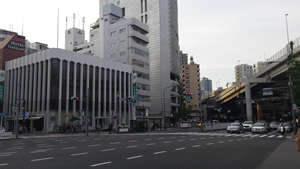
Street of Azabu-bujuban
However, despite being such a clean city, Tokyo has one dirty aspect: smoke. People smoke. A lot. In public.
Although smoking certainly exists in the United States, it’s on the decline. You seldom see people smoking residential areas in cities, especially areas abundant with children. Yet, Tokyo, a city known for its modernity, seems to be plagued by a surplus of cigarettes. I’ve also noticed that when there is litter (as rare as it may be), it is usually a cigarette or cigarette box. After speaking to some KIP students, I learned that smoking isn’t nearly as frowned upon in Japan as it is in the United States and is fairly popular.
One other notable, surprising aspect about Japan was their reception towards foreigners. In Tokyo foreigners are a common sight. You often see non-Japanese students or tourists in the subway or in restaurants. However, when we traveled to Nagano this past weekend, there was a noticeable change in the way the Japanese people around us behaved. Don’t get me wrong; on the whole, everyone I’ve interacted with here has been incredibly understanding and welcoming. Even when I butcher my request at the 7-11 nearby, the employees still smile and help me out (and maybe laugh a little). In Nagano as well, the hospitality was great. But, there was a very noticeable aspect of foreign intrigue. Nagano rarely has outside visitors, so you could tell people were examining (and even discussing) our mannerisms. At its worst times, it felt like a human zoo. Although I knew we would be foreigners, I never expected this level of outsider-intrigue (or perhaps borderline xenophobia). In hindsight, it’s very understandable. I’ve grown up in a melting pot of cultures, of ethnicities. No one particularly ‘stuck out’ or was an ‘outsider’ because everyone understood individuality and understood how people came from different places. When I traveled abroad to India, I had the opposite phenomenon occur. Although I was foreign, I didn’t stick out due to my heritage. In Japan, both of these scenarios fall through. I am an outsider through and through and that has predominantly been the thing to which I had the most trouble adapting.
Another adventure from this past week has been our daily language class. I’d been looking forward to learning Japanese since we had left from the United States, and now, after a week of class, I can definitely say that my excitement was warranted. Our teachers are warm, receptive, and knowledgeable. Each class is jam-packed with a ton of information; my knowledge of the Japanese language has grown exponentially since arriving.
The Japanese language is really interesting. Sentences are structured in Subject-Object-Verb form and never deviate. This was one major difference I noted between the English language and the Japanese language. English is a much more fluid language, which probably adds to its complexity (and can understandably make it hard for people who are used to a structured language to learn). But, I’ve kind of experienced the reverse problem learning Japanese. Since Japanese is far more structured, it’s hard to always adhere to the stricter grammar rules of the language. Plus, since I don’t speak with perfect English grammar all the time (shocking, I know), getting ideas in English translated to Japanese in my head becomes fairly difficult. But, I think I’ve caught on pretty well so far. The biggest difference between the languages with which I’m familiar and the Japanese language is the presence of particles. Particles are like prepositions in the English language, but come after a word in a sentence (a postposition). Learning how these particles function is absolutely essential and it can get difficult at times (especially when a single particle can mean myriad things). One way I’ve been trying to study the language has been actually studying the English language. By formally understanding sentence structure in English, the meaning of Japanese sentences becomes a lot easier to determine. Reading is also quite a challenge, but I think more time (and more studying) will help me out there.
Question of the Week?
One big question I have about Japan has to do with greeting culture. I’m a big high-fiver. A fist-bumper. A hugger. A hand shaker. Are there any popular forms of non-verbal communication, particularly greetings in Japan? So far people seem only marginally comfortable with the high-five. I’m holding out, for now.
Intro to Nanoscience Lectures
The nanoscience lectures so far have been great. As a theorist, Dr. Stanton was able to communicate a lot of the nitty-gritty physics behind semiconductors and terahertz dynamics. In addition, the guest lectures this past week were incredible. Ishioka-sensei from the National Institute of Materials Science in Tsukuba gave an amazing lecture as well. It was less science heavy as she talked about what it was like to be a prominent female researcher in a male-dominated society. In additional, her description of her labs’ femtosecond spectroscopy setup was interesting; I noticed a lot of similarities between her setup and Kono-sensei’s lab back home. Finally, Saito-sensei gave a funny and informative lecture about carbon nanotubes and their various applications. I would like to learn more both about semiconductor physics, maybe clarify a few concepts in Dr. Stanton’s first lecture. I also want to learn a bit more about carbon nanomaterials, especially graphene. We didn’t talk about it too much this week, but hopefully Kono-sensei’s lecture next week will be able to answer some of my questions.
Initial Research Project Overview
I have been able to communicate with Kato-sensei at the University of Tokyo to learn more about my project that I will be working on. I will be studying carbon nanotubes and their application as transistors. Carbon nanotubes are interesting in the fact that they can be either a metal or a semiconductor, depending on the way the carbon “sheet” is rolled up into a tube. Nanotubes, as you might be able to deduce, are 1-D materials (quantum wires). I will be studying mainly the electrical properties of the material, investigating the gate voltage dependence of carbon nanotube transistors. Carbon nanotubes have a hysteretic behavior that makes that gate voltage dependence difficult to analyze. My project will be fabricating the transistors and trying to eliminate the hysteresis. We will be using photoluminescence microscopy in order to analyze the gate voltage for individual nanotubes. Transistors are the backbone of all modern computing devices, so the applications are virtually limitless. I’m really looking forward to the project!
Although it’s been over a week now, this culture report will be focused on our trip to Nagano and my impressions of the both the area and the activities I did there. I spoke a little about one particularly phenomenon I felt during the trip to Nagano (about how I was under constant scrutiny, an outsider through and through) in last week’s report, but I’ll try to focus a little bit more on the different experiences that we had in Nagano and the interactions with the various people I had to privilege to meet.
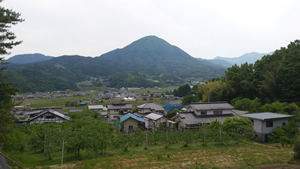
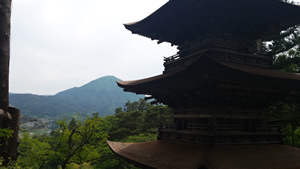
Since I won't be talking about it, I might as well include a couple pictures of how gorgeous Nagano was.
We spent three days in Nagano (Friday-Sunday) and each day was filled to the brim with activities. Although we did so much (including but not limited to: planting rice, meeting village locals, having an exquisite, multi-course dinner, visiting a Buddhist-shinto shrine filled with hand-made stone statues, taiko drumming, staying at a traditional Japanese inn, taking in a dip in a traditional Japanese hot spring, discussing with Japanese students the merits of cell phones in an academic setting, having a massive bonfire-barbecue extravaganza, sleeping in a bungalow in the mountains, witnessing the sheer beauty of the mountainous region, making soba noodles, eating said soba noodles, talking to high school students, and drinking the finest drink known to man called Bickle), I only want to focus on a couple truly meaningful moments to me.
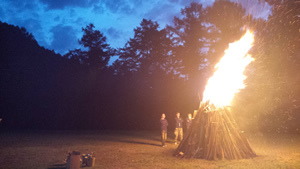
Bonfire in Aoki Village
The first, of which, was the actual traveling to Ueda City on the Shinkansen Bullet Train. The bullet train was amazing. It might just because Packard-sensei was able to get all of into a really nice reserved coach, or it might be because of the amazing vending machine drinks I had on the way, but I absolutely loved the trip there. However, it is worth noting that I also had my most frightening experience abroad during this faithful trip. Unbeknownst to me, on my way to the Shinkansen (through the Tokyo subway), I realized that I had lost the ticket that Packard-sensei had gave me. As I don’t think I’m one to panic, I calmly accepted my fate as completely screwed and (amidst scrambling around my backpack and pockets trying to understand where the ticket possibly could have gone) confronted Packard-sensei with my mistake. She was not happy, to say the least. Everything about this trip was organized to the tee and for me to be so absent-minded and disorganized was not only out of character, but also extremely sobering. Packard-sensei managed to convince the Shinkansen ticket worker to give me a voucher, and ultimately I was able to ride unhindered (by the way, I am now convinced that Packard-sensei is the most powerful woman in Japan); however, I will never forget a ticket ever again in my life. There is such a prevailing sense of order that I’ve noticed since I’ve been here and I think it really affects where your priorities have to be. You have to be organized and you have to punctual to mesh with large parts of everyday life in Japan. If there is anything I learned that will stick with me for the remainder of this adventure in Japan is that sense of punctuality and order integrated with day-to-day life.
The second experience that I want to touch on is my experience taiko drumming with a local school. About 5 minutes away from the Ryokan (Japanese inn), there is a small drumming studio. We were privileged enough to visit the studio and have them both perform for us and teach us how to play the taiko. It was absolutely incredible. As a percussionist, I had already been super excited to hear and learn, but it wasn’t until I heard the first beat of the drum did I truly understand how amazing it was. As described by the taiko sensei, the deep bass of the drum sounds like the beat of the heart, something intrinsic to all humans. So, it’s natural for the performance to be very emotional and tied to the entire body of the performers. It was clear that each of the performers was giving such incredible physical effort to the performance, and the level of synchronization was mind-blowing. I could go on for days about the performance and how interesting I found it. But, the highlight of the night came when we were offered the chance to learn a whole routine. We paired up with the students, who ranged from elementary school age to high school age, to teach us how to play the instrument. Luckily for me, I had the best teacher.
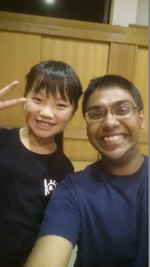
My Taiko sensei
Meet Miku-sensei. She’s 8. And she’s the coolest, most talented 8 year-old that I’ve ever met. To be completely honest, we didn’t really get along immediately. She would laugh at me when I didn’t get the steps and rhythm correct, but was warm to my broken, amateur Japanese when I tried to communicate with her. By the end of the routine, I had asked her if she was my tomodachi (friend) and thankfully she said yes. I ended meeting a few of her other very talented drummer friends as we listened to the advanced group play one last performance with us. It was here where I had the most eye-opening experience in Japan so far. Miku’s older brother, Raito (who’s 9), was one of the kids that I met there. These kids were all native to Ueda City and Aoki-mura (the village where we stayed at), so what ensued was perhaps not surprising in retrospect. As we were sitting down and chatting, Raito and one of his friends began to pinch me. As it was a little annoying, I asked what they were doing, to which they responded, “choko!” and pinched me again and pretended to eat what they had just pinched. Choko is the shortened word for chocolate in Japanese.
I had commented in last week’s report on how Nagano typically didn’t see many outsiders, particularly from outside of Japan. But, it had never occurred to me that these kids may have never seen a person with a different skin color, a different physical appearance, a different ethnic background, than that of their Japanese peers. Although I had been growing accustomed to being “that foreign person” everywhere I went, it still completely surprised me. I expected the hospitality and I expected the order (clear when we met the villagers and especially the high school students, who were nothing but first-class hosts to us), but I did not expect the perhaps lack of exposure to other cultures to both youth and adult alike. Regardless, going to Nagano is something I’ll never forget. I could write a novel over my impressions of all of the other experiences I had there and I’m truly grateful for having the opportunity to experience it all.
Research Internship Update:
This week’s nanoscience lectures were certainly helpful. Kono-sensei first lectured a sort of overview of carbon based nanomaterials and the different applications they can have. We additionally were able to get off on a bit of a tangent surrounding the physics of electrons and phonons, which I think was really crucial to my understanding of some of the tougher concepts surrounding the terahertz time-domain that Dr. Stanton went over the week prior. One particularly interesting thing we spoke about in this lecture was the emerging new materials apart from Carbon nanotubes and graphene that are being synthesized and implemented in various different ways. One example was transitional metal dichalcogenides, a series of materials that are pseudo-2D materials, or materials that somewhat resemble graphene’s completely 2D single-atomic layer structure. The research I do back home investigates some interesting phenomena in these materials, so it was nice to learn even more about them during Kono-sensei’s lecture.
That day we also received a lecture from Tonouchi-sensei, a prominent terahertz research from Osaka University. Although his talk was harder to understand, it was clear that the work that he does in his lab is incredible. We learned about a lot of interesting ways the terahertz time-domain can be utilized to create devices for sensing and imaging, among other applications. On Thursday, we had another lecture from Kono-sensei, this time a lot more in-depth. We investigated the physics of interband and intraband absorptions, and how materials like nanocarbons have very interesting properties, like having unique band structures and ultra-high carrier mobility. One huge thing I learned (that I was also able to recall from Saito-sensei’s lecture) was how the variation the fixed energy levels of single-walled carbon nanotubes depends entirely on the diameter of tube you create, and one can measure this diameter through photoluminescence (PL) excitation spectroscopy. I’ll be doing PL spectroscopy for my project at Tokyo University, so it was great to learn about it more during the lecture. We also went over some really cool ways to synthesize aligned carbon nanotubes, including chemical vapor deposition, wet spinning, and, Kono-sensei’s favorite, the vacuum filtration method. I think that the nanotubes I’ll be growing for my internship will be through chemical vapor deposition, which is another connection I was able to make between my future research and the lectures.
Preparation for Research Internship - Article Review
For the brief paper review, I decided to summarize a paper that Kato-sensei’s lab published and I was assigned to read. It is titled: “Gate-induced blueshift and quenching of photoluminescence in suspended single-walled carbon nanotubes.”
S. Yasukochi, T. Murai, S. Moritsubo, T. Shimada, S. Chiashi, S. Maruyama, and Y. K. Kato. "Gate-induced blueshift and quenching of photoluminescence in suspended single-walled carbon nanotubes," Phys. Rev. B 84, 121409(R) – Published 22 September 2011. Access Online
The major purpose of the paper focuses on analyzing gate-voltage effects of carbon nanotube field-effect transistor (CNT FET) devices on the PL spectra for the nanotubes. This paper not only examines the electric field effects on this optical property (the PL emission energy) of carbon nanotubes, but also outlines some incredible synthesis techniques for creating these devices. First, the paper outlines the methods for creating the CNT FET. Because PL is quenched or eliminated if the nanotube is backed on a substrate, they grew suspended single-walled CNTs along a trench of substrate. To create this trench along the silicon substrate, the researchers etched 1 micrometer wide trenches that are 5 microns deep. Then, they selectively grow the source and drain metal contacts on to the substrate. Finally, carbon nanotubes are selectively grown across the trench using chemical vapor deposition (ethanol is used as the carbon source). To now measure how gate-voltage affects the optical emission properties, the group uses a Ti-sapphire laser to excite the sample and collect PL emissions. The nanotube’s chirality (the specific wrapping that determines the energy gap information of that particular nanotube) is determined through PL spectroscopy. The researchers then try to collect spectra of PL emission energy for each individual nanotube that is grown at varying gate-voltages applied to the device. They noted that in all three nanotube samples, as the gate voltage increased, the emission energy at the peak PL intensity (respective to that gate voltage) blueshifted, or increased in energy. Additionally, they note at higher gate voltages, PL is completely quenched. This finding is important for two main reasons. First, blueshifts are surprising from a physics standpoint because previous studies had shown that gate-induced carriers cause screening which causes redshifts (decrease in energy). Secondly, this entire study is important from a materials standpoint. Understanding more about the optical properties of a device like a carbon nanotube and how those optical properties change when interacting with an electric field are important as that understanding can have huge potential in the field of optoelectronics. The paper concluded by attempting to find a reason for this induced blueshift that was observed. Unfortunately, I think I need a little bit more background knowledge to understand the testing that was done for this; however, the paper argues that it is perhaps doping-induced relaxation of excitons that is strong and causing both the blue shift phenomenon and PL quenching phenomenon.
One of the defining points of everyday life in Tokyo is the use of the immense public transportation system. One of the first things that we received when we arrived in Azabujuban three weeks ago was a map of the Tokyo subway system. That colorful, intricately-designed sheet of paper has been absolutely vital to our way of life here. Due to the sheer size of Tokyo, if something isn’t within walking (or biking, which is quite popular) distance, the only reliable way to get somewhere is by subway. Personal transportation like cars or motorcycles is not nearly as popular as using the subway; in fact, from our conversations with the KIP students, college students and younger rarely have cars to get around. This is quite different than where I come from, a suburb of Kansas City, where, in high school even, many of my friends had their own cars. Then again, there wasn’t any reliable mode of public transportation back there.
Speaking more to that point, my experience with public transportation is quite limited. I visited New York once in high school and got a taste of the subway system for the first time. Even in Houston, I don’t use the metro that often and only use the shuttle system once a week at most. There is usually someone with a car that I carpool with to get to places that are truly out of walking distance. So, you could imagine that living in Japan has been quite the new experience for me.
I’ve used the Tokyo subway system almost every day so far, and with that I think I’ve picked up on some interesting etiquette and behaviors that may or may not be similar to an American subway system (I truly wouldn’t know).
The first and perhaps most apparent thing is the sound. Or, I should say, the lack thereof. Rarely do people talk on the subway. I distinctly remember the glare I received from a random Japanese man on my first subway ride ever. We were talking pretty loudly and it became very clear that that was a definite no-go. That’s not to say people don’t speak on the subway; there definitely are people who talk to each other (especially if they are friends or are riding together as a group). However, you would rarely see to random people interacting on the subway. You also will never see someone talking on the phone while on the train. On the other hand, people are always playing mobile games, texting, listening to music, or reading using their smart phones or electronic devices. I don’t think this is particularly abnormal. However, from all the viral videos I’ve seen of impromptu musical performances in American subways, the Japanese subway system might be a little more on the reserved side of public transport.
There is also a very interesting entering/exiting ritual that takes place on the subway. You are directed to make two diagonal lines on the sides of the opening train doors and wait until people exit from the middle. Now, there isn’t anything particularly strange about this; in fact, it makes the system seem very organized. However, the surprising part of this ritual is how often it is broken. Yes, typically lines are formed and the exiting people shoot out from the train in the middle of the lines of people. But, it seems that every stop, there are a few rushing people that forgo the organization and bolt in or out. The subway seems to be the one aspect in Japan that isn’t subject to that intense sense of order and harmony (wa, in Japanese).Especially during rush hour times, where you can see poor salary men’s faces smushed against the sliding door due to the sheer number of people crammed into each cabin, the subway is a chaotic, yet quiet, of the otherwise orderly Japanese society.
I really haven’t used any other forms of public transportation outside of the subway system. Yes, we travelled by shinkansen to Nagano, but there was nothing unusual about it. It was train that was, surprise, faster than a normal train. The cabins were normally filled (with both sitting and standing people) and normally attended to. Likewise, we have used the regular JR trains to travel to various places (like the Elionix headquarters) that were very similar to any other train experience. I think I’ll pick up more of the various idiosyncrasies of the Tokyo subway as I get started on my research internship and have to commute at least 20 minutes on the subway every day. It’s entirely possible that these impressions will totally change. Week 4, here I come!
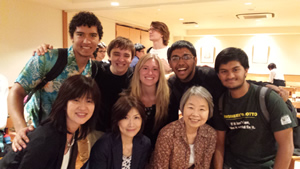
With the end of orientation also comes the end of our language classes; we said goodbye to our fantastic senseis pictured here. Try to ignore Cole’s majestic face in the background.
Intro to Nanoscience Seminar
This week was our last week of extremely helpful nanoscience lectures. Dr. Bird, from SUNY, was our main lecturer. His first lecture consisted mainly of a review of semiconductor physics. Although a lot of the material was covered in Dr. Stanton and Dr. Kono’s lectures from the past weeks, Dr. Bird’s lecture allowed us to really grasp the essential basic concepts to our research. Namely, understanding what electron and holes actually are and how they behave in semiconductors is essential background information that I was able to solidify through his lecture. We also were able to further analyze, from a physics standpoint, what basic semiconductor devices are. For example, we learned a lot more about the pn-junction, the most useful and fundamental device that is created with semiconductor materials. We talked about them with Dr. Stanton in week 1, but further discussing them with Dr. Bird really helped me out. In fact, I kind of which we had first had this lecture in Week 1, before Dr. Stanton and Dr. Kono’s lectures. I think I would have been able to grasp more of their higher-level information if I had been able to learn these fundamentals a little better. At the end, Dr. Bird even gave us a little bit of a science break and spoke about his experience as a foreign research in Japan! Later on in the week, Aoki-sensei from Chiba University gave us a lecture on a new type of microscopy, related to AFM (atomic-force microscopy). He talked about how there is an electric field and force caused by the small AFM needle, and that potential difference that is measured can be valuable in characterizing new materials. Unfortunately, Aoki-sensei’s lecture was pretty dense, and I think a lot of the finer details went over my head. However, I definitely was able to learn something new about the evolving world of nano-microscopy and greatly appreciated Aoki-sensei taking time out of his busy schedule to give us a lecture.
Dr. Bird’s second lecture was centered on graphene, the material composed of a single-atomic layer of sp2 hybridized carbon atoms. There were several points brought up in this discussion that I’d like to highlight. First, we spoke about Moore’s law. Moore’s Law was an observation made years ago about the exponential increase in the number of transistors in a single computer chip. About every 18 months, the number of transistors we can cram onto a chip doubles. However, we learned about how this growth will eventually be unsustainable unless we take advantage of novel electronic nanomaterials like Graphene or Carbon nanotubes. We also spoke about creating nanostructures and how there are two main approaches: top-down and bottom-up. Top-down approaches take a big, bulk material and use techniques to make it nano-sized. An example of this is Electron Beam Lithography, where one takes a larger material and cut into it with a fine electron beam to essentially carve out nanostructures. You can think of it as analogous to using a cookie cutter on a large sheet of pastry dough. Bottom-up approaches build the nanostructure starting from smaller material, sometimes even a single atom! An example of bottom-up is chemical vapor deposition, where some gas is introduced to the substrate and a nanostructure is grown gradually as atoms from the gas react with a catalyst. At this nanoscale, semiconductor materials and devices take advantage of quantum effects. One example of this has to do with electron-hole interactions and the various, quantized energy states in a typical semiconductor. In these materials, electrons can only occupy certain energy ranges, called bands, while there are certain energy ranges that are forbidden, called gaps or band gaps. However, due to the magic of quantum mechanics, electrons can get excited from one energy band to another and cross a band gap. In semiconductor devices, this band gap is small, and this transport of electron and holes across different energy bands is the fundamental way that electricity is conducted. Additionally, the band gap is completely responsible for all sorts of interesting things that semiconductor devices are famous for, such as light emission (in LEDs) and generating photocurrent (in solar cells).
One famous nanomaterial that we learned about was graphene. Graphene is very interesting because it is a 2D material (a single atomic later) with incredible mechanical and electrical properties. One attractive property of graphene is its crazy high conductivity, the highest of all known materials. Electrons in graphene have zero effective mass, which mean that they can fly across the material (similar to a photon) with an ease seen in no other material. However, one challenge that scientists and engineers have faced is making semiconductor devices using graphene. Graphene has no band gap, which means that it does not have a lot of the characteristic properties of a semiconductor material. For example, if you attempted to make a transistor out of graphene, you would be unable to turn it off, as all parts of the energy band structure of graphene can carry electrons or holes through the device; however, with a traditional semiconductor material, you can turn off the transistor by using the band gap as a void through which electrons and holes cannot cross. Scientists are attempting to circumvent this shortcoming of graphene by utilizing its unique 2D structure and creating heterostructures; or materials that combine two different layers of material. By layering graphene with other materials, one can create a heterostructure that can capture those characteristic semiconductor properties and create useful electronic devices.
I’m incredibly excited to start my research internship next week. I think the papers I’ve read so far have given me a decent background into what my project will be doing. I know that I’ll be fabricating and analyzing Carbon Nanotube based Field-effect transistors. A couple questions that I have mainly have to do with the ‘why?’ Why do we use ethanol as our carbon source in CVD? Why use silicon as a substrate? Are there other methods to fabricating these FET devices? Why use this way (which, as I outlined in last week’s report, has to do with some crazy E-Beam lithography, spin coating, and chemical vapor deposition)? Hopefully all these questions and more will be answered come Monday!
Week 4 marked the beginning of our research internships. I am working in Kato-sensei’s lab at the Institute for Engineering Innovation at the University of Tokyo. I came in right before lunch time and was greeted by a couple of my lab mates, Akihiro and Noriyuki, who were working on one of their samples. I then was able to meet Kato-sensei. There weren’t any special festivities or activities on my first day. After I introduced myself to Kato-sensei, he toured me around the lab and gave me a safety briefing over all of the equipment and chemicals that the lab has. I then presented the gifts I brought for the lab to my lab mates and I introduced myself to all of them. The lab is pretty small, only nine people max. But it makes for a very comfortable environment. Unfortunately, my graduate student mentor was sick on the first day; however, I was able to sit and chat with Kato-sensei for an hour to discuss my project and ask all the questions that I’ve had from reading the papers that he sent me. I definitely felt ready to get started!
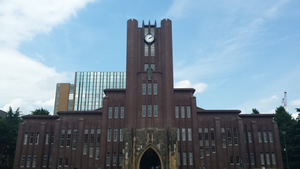
The University of Tokyo! It's definitely a great looking campus. Reminds me of the Sallyport back home at Rice.
My mentor’s name is Takushi Uda, and he along with a few other lab members here or there, have helped guide me on my project so far. Takushi is a PhD student in Kato-sensei’s lab and actually was in Germany at a conference the weekend before I arrived. He unfortunately caught a cold and is suffering from jetlag, so he hasn’t been at the lab as often as he usually is. But, I was able to meet with him and we went over the schedule for my project and got started. Everyone in this lab speaks English pretty well! Although some of the members are a bit quiet, each have been able to at the very least keep a conversation with me or answer some questions I had about optoelectronics. In addition, they have all been very helpful and friendly to me (even teaching me some useful Japanese slang).
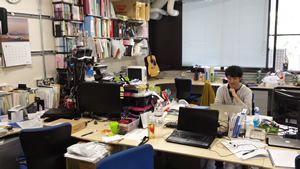
A look inside the student office space. The desk in the front with the lap top is mine!
Speaking of language, the Kato lab has a lot of English…and a lot of Japaense. Kato-sensei actually did a lot of his schooling (middle-school, graduate, and post-doc) in the United States and speaks (obviously) fluent English. This is great for two reasons. First, his American accent was entirely refreshing when I first met him. It makes it very comfortable for me to ask questions and speak up, as I know at least one person will always understand me. Second, his background influences the lab culture. He requires all
group meetings to be spoken in English and all the lab members to go out of their comfort zone, language-wise, to ask questions. Everyone doesn’t speak English all the time, however. Especially in conversation or in quick questions to Kato-sensei, the students will speak in Japanese. This can be a little annoying or hard to deal with sometimes, as I often am in a conversation that quickly turns completely into Japanese. I would then have to ask afterwards what everyone said. I don’t know nearly enough Japanese words to hold a technical conversation or ask scientific questions, but I’ve been able to stay in the loop, albeit a little slower than I would like. The Japanese I do know has been absolutely great in helping me develop a rapport with my lab mates. The little bits I do know seem to come in handy when talking about day-to-day life or ask basic, non-science questions and have definitely helped me become friends with many of the lab members.
I began working on my research project starting right after I met with Takushi, and have been working on it for the last week. By talking with Takushi, it was clear to me what the main goals of my project were and some basic checkpoints that I should be aiming for. So far, any major issues I’ve come across I’ve been able to solve or work through with the help of my lab mates and Kato-sensei. It’s actually going really well! I am really happy with how I have progressed so far and can’t wait to continue in the weeks to come.
As for a question of the week: I’m in a new location now, a shareroom apartment in Morishita. And, with all new places, I don’t really know what’s around me. Rocco and I did some exploring when we got here, but my big question is what is close by to Morishita? Are there any good restaurants? I’ve tried asking my lab mates, but none have them have been by Morishita before! Google maps has helped a little, but even that is a struggle (reading Japanese is still pretty difficult). Hopefully after a bit more research I can find some good places to go!
Overview of Orientation Program & Language Classes
The beginning of the research internship also marks the end of the three week culture, nanoscience, and language orientation in Azabujuban. Overall, it was an absolute privilege to be able to learn from such great senseis, to travel and experience such unique places in Japan, and to make friends with the awesome KIP students. I would still hold that our trip to Nagano was the most interesting and enjoyable experience I’ve had in Japan. It was an absolutely beautiful area and we were able to do such incredible things that I’m sure I wouldn’t have been able to do had it not been for the NanoJapan program. In addition, the discussions with the KIP students were enlightening; it was so cool to be able to see the Japanese college kids’ perspectives on topics that affect us all, like cyber bullying and marriage equality. On the other hand, sometimes some of the nanoscience guest lecturers were difficult to understand or simply spoke way above out heads. It was difficult to retain any information from some of the talks.
The Japanese language classes were invaluable to me. I think I was able to pick up the spoken language fairly well and have been able to hold conversation at a basic (and slow) level with all my lab mates. Every day, I seem to learn a new word or phrase, especially when it comes to trying to ask questions to my lab mates about the science. Also, when we hang out in a more casual setting, I get to learn a lot of casual Japanese from them. My language goal for the summer is still the same as I had coming in: I want to be able to hold a full, coherent conversation in Japanese. I think it will require a bit more studying on my end (especially just learning some more verbs), but I think I can do it! I also plan on continuing learning Japanese formally even after the program through my school.
I think the most important thing I’ve learned about Japan since arriving has been the importance of etiquette and order. There is such a large emphasis on doing something the way it is meant to be done, and not necessarily just completing the task. By going through the motions, from even on the most mundane things (like buying an item from a convenience store) to the more formal (like praying at a shrine), I think people just become nicer and more understanding. There is rarely any commotion or disturbance in everyday life. It’s rather peaceful. And as a foreigner, by at the very least trying to adopt certain behaviors has made the local Japanese people a lot more understanding. They can see that you are trying, and as a result, try their best to help you out. I remember eating at the UTokyo cafeteria and attempting to ask some questions about the food I ordered (mostly just checking if there was meat in it, as I’m a vegetarian), and although I might have butchered some words, the cafeteria workers were so congenial to me and we were able to communicate very well. I even got an extra yasai kuroke (a fried vegetable cutlet) for my efforts (or maybe because they felt bad for me…)!
Although it’s been month since I arrived in Japan, I still have a few questions that I hope will be answered as I continue living here:
NanoJapan Research Project Update
Research Project Overview: My project is centered on eliminating gate-induced hysteresis in single-walled carbon nanotube field-effect transistors (SWCNT FETs). SWCNT FETs already have shown great promise, particularly in the field of optoelectronics. Kato-sensei’s lab does a lot of work with synthesizing these devices and then testing their optical properties. The main optical property I will be working with is photoluminescence emission (PL emission) of the suspended SWCNT as a function of an applied gate-voltage. However, these devices experience hysteresis, or time-dependent behavior, when it comes to applying a gate-voltage. In other words, if I change the gate-voltage to some amount, and then bring it back to the original amount, the actual voltage will have shifted a little bit. This causes an inability to truly ascertain the gate-voltage dependence on these devices. This hysteresis has been studied quite a bit, and although there many different theories on why it occurs, it’s largely thought that water from the atmosphere that is adsorbed on to the silicon substrate traps the charge as you change the voltage, leading to the hysteretic behavior. What my project entails is creating a sort of vacuum box to mount the SWCNT FETs to hopefully eliminate the hysteresis and get accurate measurements of the PL emission as a function of gate-voltage. I’ll be not only creating the vacuum box itself, but also will be setting up the optical system for measurements and helping fabricate the FET devices.
Research Methods: In order to create the vacuum box, I’ll be using a cryostat. Cryostats are devices that control temperature and pressure of a sample contained inside of it. We aren’t particularly concerned with temperature, but since it can control the pressure, it makes a good base for the vacuum box. However, the cryostat isn’t equipped to hold a sample that needs to be hooked up to a voltage. So, I’ll be hacking the cryostat a bit. I have been creating a print circuit to fit in the cryostat and wiring the sample to a voltage to do initial measurements. Once we check that out, we will need to create the FET devices using electron beam lithography and chemical vapor deposition. Then, we will mount the devices in the cryostat and place the cryostat within an optical system. There, a Titanium-Sapphire laser will be used to probe the sample and take PL emission measurements. It’s quite a lot of stuff, but it’s going really smoothly so far; I’m having a lot of fun, too!
Training: So far, since I’ve already begun my project, I’ve had to learn the print circuit software to design and order the circuits to be mounted in the cryostat. In addition, I’ve been doing a lot of reading to learn more about the physics and chemistry of the hysteresis in these devices. Finally, I’ll be doing more reading on optical systems and trying to understand how the PL emission spectroscopy actually works and what the setup must look like. Along the way, I’ll also be learning some basics in the actual device fabrication, including using E-beam lithography and learning more about the lab’s CVD system.
Timeline: Our basic timeline is the following: Complete the vacuum box and optical system by July 7th (when I get back from Okinawa) and do the PL measurements and data analysis during the three weeks I have after the mid-program meeting. During these three weeks, I’ll also be creating the final poster presentation for the NanoJapan program with, hopefully, some great data. I’m a little ahead of schedule right now on phase 1, so we might even be able to do some preliminary electronic (non-optical) tests on gate-dependence before I leave. That will give us a good idea on whether the vacuum box is actually quenching the hysteresis or if we need to make any adjustments. So far, it’s going really well!
I think I’ve been lucky to have such a smooth transition into my lab. I’ve now finished two whole weeks working in the Kato lab at the University of Tokyo, and it’s been going quite well! Although I’ll go into the details of my progress on my project later, I think the majority of interactions I’ve had with my lab mates had to do with asking them about information regarding my project and about science. In these interactions, sometimes it’s been difficult to both ask questions and understand answers. As you can imagine, even though my lab mates are incredibly knowledgeable, a lot of that knowledge is only communicated in Japanese. Sometimes, they have trouble communicating certain scientific words and more advanced concepts in English. One noticeable time this happened was last week when I began soldering some wires to pins. I had asked my mentor, Takushi, how exactly I should go about the soldering (especially with our pins and wires numbered slightly differently). What I thought was a short answer led to a drawn-out conversation. I don’t remember what exactly happened, but we ended up getting into the backgrounds of how to solder. Takushi even busted out Weblio, an English-Japanese translation website, to get some words straightened out. I ended up having to do a little charades to help him understand the question, but after he understood my query we got moving forward and all was well.
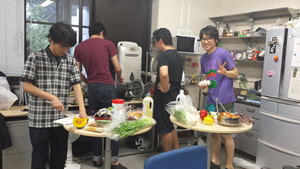
Some of my lab mates preparing a feast for my welcome party last Wednesday! They are all awesome.
Situations like that have only happened a few times since I’ve arrived, but nevertheless they can be (very) mildly frustrating. Even in that last example, after Takushi realized what I had been asking, we both had a good laugh (or maybe he was laughing at my acting skills). So, really, I’ve had no significant difficult cross-cultural scenarios. All my lab mates speak English very well and are constantly encouraged by Kato-sensei to explain scientific concepts in English as well. Beyond communication, my lab functions very similarly to an American lab, probably due to Kato-sensei’s background in America. There aren’t any extra formalities other than common sense kindness and compassion, people are very forgiving for things that are traditionally faux paus in Japan (arriving late, eating and moving around, being a little loud), and my schedule is quite flexible. Like I said before, maybe I’m lucky. But, the longer I live in Japan the more I realize how much more similar everyone here is to people in the states rather than how different they are. It’s also possible that the college environment is a little more Western influenced than other areas, so I haven’t experienced any major cultural clashes.
Even outside the lab, though, I haven’t had any significant cross-cultural mishaps. The biggest thing that had happened was a mix-up in food due to vegetarianism. Last week, I went to an Italian restaurant and asked (in Japanese) if a certain dish had meat in it. After the waitress asked the chef and said it didn’t, I ordered it. However, it turns out it did have meat in it. So, I asked the waitress about it, she apologized profusely and had the meal made again without the meat. This has happened twice in Japan and countless times living in America. And, it was handled in the exact same way it would have been handled if I were in some Italian restaurant in Houston, if not even better. It’s been smooth sailing, here in Japan!
NanoJapan Research Project Update
This past week I made significant progress on building the vacuum box for my project. For a recap, my project consists of creating a vacuum box to place single-walled carbon nanotube field-effect transistor devices (SWCNT FETs) in and measure their optical and electronic properties. The purpose of putting them in the vacuum is to eliminate something called hysteresis in the gate-voltage. Basically, when we alter the voltage across the device and then return it back to the original value, the voltage doesn’t go back to its original value. This makes it impossible to actually deduce what the gate-voltage dependence is of certain important properties (like current or photoluminescence emission). This is theorized to be caused water molecules that are adsorbed on the substrate of the devices and are trapping charges. So, by putting the devices in a vacuum box, we hope to eliminate those charge traps and the hysteric behavior!
We are using a cryostat (a device that can alter pressure and temperature inside of it) as our box. I finished wiring the voltage plug through the cryostat and onto the print circuit that I designed in week 1. Then, we finished screwing the print circuit into the laser-able part of the cryostat. Now, it’s ready to hold a device!
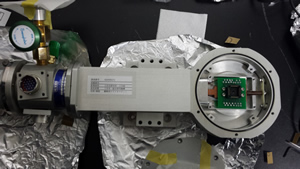
A top down view of the finished box (with the cover off).
We’ve basically divided my project into two main phases. Phase 1 (pre-mid program meeting) has me building the vacuum box, finish the line from the cryostat to the voltage box, and due some preliminary testing on some older devices to make sure the box is working. There are two main preliminary tests that I need to do. First, I need to do a pressure test. We will hook up the cryostat to our mobile turbo pump (which is super cool) and make sure that it actually functions as a vacuum box. We can figure out if there are any significant leaks during this test and if any adjustments need to be made to the cryostat. The second test that we will do is a current vs gate-voltage test. This will be an extremely important test, as it will show us if there is any hysteresis in the gate-voltage. We will place a device in the cryostat, hook it up to the voltage, and analyze the current as a function of various voltages. Depending on the curve of the graph, we can see if there is any hysteretic behavior.
I’ll hopefully have both of these tests done by the end of week and have some data and action points to talk about for the mid-program meeting. In order to setup for these tests, I need to both hook up the pump to the cryostat and create a line from the cryostat to the voltage box. This requires more soldering. Woo!
That previous “Woo” was somewhat sarcastic. The biggest challenge I’ve faced so far was finagling and soldering all the wiring within the cryostat. And, surprise, we got an even harder soldering challenge coming up next. The cryostat has a 19-pin socket and the voltage box only has 10-pin sockets. That means that I’ll have to do some manual soldering to create a 19 to 10+9 cable to connect the cryostat to the voltage. I’ll admit, sometimes soldering is quite relaxing. Plus, the smell of whatever chemical vapor I’m inhaling is quite pleasant (Is it lead? It might be lead). However, it is quite difficult with how small these wires are. Plus, I have to keep checking to make sure the numbering of each wire is in order so that we collect accurate data. It’s sometimes been a struggle. But, the immensely rewarding feeling I got after wiring up the inside of the vacuum box was great; I’m looking forward to feeling that again once I get this next cabling finished!
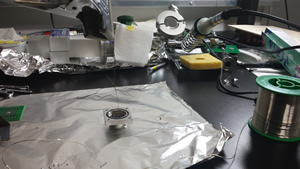
From modest beginnings: my very first wire soldered into the cryostat's socket.
That’s about it from my end. I’ll be going into the clean room and learn how to use the electron-beam lithography machines this week as Takushi creates the devices that we’ll be using. Hopefully, if everything goes smoothly, we’ll be able to start assembling the optical system that we will be using to test gate-voltage dependence of PL emission – those measurements are all apart of phase 2!
I feel like I start each one of these reports with some exclamation about how I can’t believe how much time has passed…this one is no different.
I can’t believe it’s already been six weeks! Half way done with the research internship!
It’s safe to say that throughout all of the experiences I’ve had in Japan so far, I’ve faced several challenges that, in retrospect, have definitely opened up new perspectives for me and helped me grow as a person. I’d like to highlight a couple of those experiences.
First and foremost was my challenge with learning Japanese. I had come into this program pretty nervous about being able to communicate with everyone I would be working with. Language is such an important aspect of life; without it, you miss out on some of the most interesting experiences, whether that’s talking to incredible individuals or understanding an event that is going on. It’s incredibly hard to immerse yourself or even become comfortable in an environment without being able to communicate freely. As someone with no background in East Asian languages (I have very little background in anything non-Latin based), I was convinced that communication would be something I would have to struggle through, not something I could adapt to. Luckily, I was pleasantly surprised about my ability to catch on and learn the language. Although I’m definitely not fluent by any means, as each day passes by I seem to be able to communicate with more people and hold up in conversations. Just being able to live somewhat inconspicuously is what I regard as one of my biggest accomplishments. It’s such a great feeling when a meal goes by and I don’t have to use that little bit of extra menu-pointing. I owe most of my progress with Japanese to the fantastic instruction we received during our orientation in Azabu-juban. Plus, being able to work daily with people who are both native Japanese speakers and fluent in English helps me work out the kinks in my everyday Japanese-speak. I definitely am considering continuing studying Japanese when I get back to school!
The second big challenge that I’ve faced has been being a vegetarian in Japan. I know I’ve already written about this in earlier reports, but it has been somewhat of a defining point of my travels. Heck, I even gave my final, end-of-the-orientation Japanese speech on how I found the Freshness Burger restaurants and their veggie burgers, and how that discovery has been absolutely essential to my survival in Japan. Growing up a vegetarian in the U.S. had also had its challenges (I’ve had my fair share of clarifying orders at restaurants or asking for substitutions), but it’s a completely different struggle in Japan. The idea of vegetarianism is far rarer here and the cuisine isn’t catered towards customization. But, to be completely honest, I’m not even close to upset about it. Yes, there have been a few frustrating times of trying to communicate in broken Japanese that, yes, bacon is meat, or no, I don’t eat fish, and yes, that includes shrimp. But I’m certainly not starving. I’ve even accomplished one of my goals of finding a favorite Japanese food (okonomiyaki! It’s delicious and the veggie varieties are plenty). All in all, being vegetarian here is a challenge, but it’s quite a rewarding (and delicious) one to overcome.
Research internship update:
My research project has been going really well! This last week, I finished all of the wiring within cryostat (what we are using as a vacuum box) and creating the cable to wire the cryostat to the voltage box. In addition, I was able to go to the clean room and assist my mentor with the electron-beam lithography (EBL) process for fabricating our carbon nanotube devices. EBL allows us to create the fine architecture of each suspended-nanotube FET. We were able to run a couple of measurements as well. First, we tested out if the wired up cryostat indeed working as a suitable vacuum. We used our turbo pump and concluded that the box did not have any leaks, which is great news. We also did current vs gate-voltage measurements in air across each of the 40 FET devices that were synthesized onto a sample chip. The data show that there are more than twenty suitable nanotube devices that are ready to be tested in a vacuum. Starting next week, we will start to run tests while the sample is inside of the vacuum and, hopefully, we will be able to see the elimination of the gate-induced hysteresis that exists in air.
I had a couple setbacks that I was able to overcome last week, all of which have to do with my new favorite pastime: soldering. We discovered that some of the pins on our device holder inside of the cryostat were not isolated; in other words, more than one pin was connected to one wire and we had a short. After doing some painstaking renovations to do device, I was shocked to discover that a new short appeared out of nowhere between two pins that I thought were okay. I learned that some solder had connected the two of them from my very first attempt at soldering! Luckily, it was easy to fix and now we have a completely isolated, wired up system. Soldering can be a bit frustrating, but completing the assembly of the vacuum box was incredibly rewarding. I can’t wait to get started on some important measurements next week!
For this week’s report, we are supposed to reflect on our experience with the Japanese language. As I’ve mentioned in earlier weeks, this program (specifically, the language classes we had during our three week orientation) was my first exposure to the Japanese language. After the tremendous help from our instructors, I think I was able to grasp the speaking basics pretty well. It’s kind of hard to ‘rate’ myself, as there are lots of different scales you can use. On a “being able to live in Japan” scale, I think I’m doing pretty well. I’ve had very few misunderstandings with the people I interact with on the daily, and through my novice-level vocab and some wild gesturing, I think I’ve even made a couple friends! On a scale of actual “knowledge of Japanese,” I think I’ll need a lot more work. My vocab is pretty limited. And, with Japanese being as complex as it is, I have a lot to learn.
To be honest, it’s been difficult to continue learning since I’ve started my research internship. I occasionally am able to review the material we covered in the first 3 weeks and go over new material (although basic) that we skimmed over from the textbook. However, due to the business of my schedule (and the lack of necessity of communicating in Japanese in my lab), I haven’t really looked at other learning tools. I have been, however, constantly asking my lab mates about new words or phrases to implement in my daily speech. Even then though, I rarely converse on a day-to-day basis at more than a superficial level with the people around me, so there hasn’t really been a reason for me to go out of my way to learn more advanced Japanese.
However, despite this, I am super excited to continue learning Japanese after the program. I am really interested in learning the language and becoming proficient in the future. I plan on starting taking Japanese language courses back at Rice. Maybe, if those go well, I can start to take outside classes or even try to apply for some language or immersion fellowships to continue my study of the language.
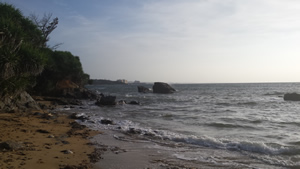
A small beach by the OIST Seaside House
Shifting gears, we just had our mid-program meeting in Okinawa. It was incredible. I could go on and on about the beauty of the island and especially the views we had from the Seaside House in which we were staying. We were able to attend the MTSA conference and check out both tutorials and poster presentations. Later on, we each gave presentations surrounding the progress we’ve made in our projects.
I was incredibly impressed with everyone’s presentations. It definitely motivated me to continue to work hard in the lab and, hopefully, come out with some neat data to present later in August.
What struck me the most, however, was the very optimistic and hopeful vibe I got from the faculty and students at OIST. When we toured around different groups and spoke to some students in different research groups (units, as they are called at OIST), they were so excited about the cool, new machinery they use and the breakthrough research that the unique structure of OIST enabled them to do. It was certainly inspiring for me that that sort of excitement is present in graduate school. It’s hard for me to say right now what my life after my undergrad will be like (like whether or not I even want to go to graduate school), but learning more about OIST and seeing the students in action has certainly put it on my radar. I’ll definitely be looking into programs that are unique like OIST for potential further education!
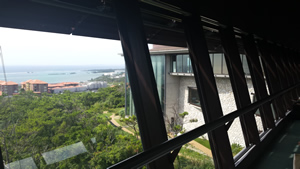
View from a Sky Bridge at OIST. Every building on the campus is built on mountaintops and connected by sky bridges. The views are breathtaking.
Research Project Update
We only had a couple days of research this week, as the majority of the time was spent in Okinawa. But, I was able to fix an electrical short that came up in the wiring of my cryostat device. We are now ready to mount the cryostat and the sample on the optical table, do alignment, and (hopefully) start getting some real data!
More updates to come next week.
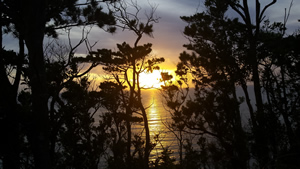
A beautiful Okinawa sunset to conclude this week's report
As I’ve mentioned in earlier reports, I’ve had a very good time adjusting to my host lab. As a brief refresher, I work with the Kato group at the University of Tokyo in the Institute of Engineering Innovation. Kato-sensei himself is quite Western, having spent both sometime in middle school as well as his PhD and Post-Doc in the United States. He speaks with an American accent and has been an excellent guide on my work and transition into working with Japan. Additionally, the lab has hosted international students and interns pretty frequently, so the Japanese students who work there are used to outsiders working there. The Japanese students also are encouraged to talk mainly in English, particularly when it comes to actual science and research matters. One good example of this is the group policy that all group meetings are in English. Although some of my lab mates are on the quiet side and don’t speak English fluently, most are able to communicate really well with me and the other American intern at the lab right now. We address each other by name, although, occasionally, when we are in a more formal setting or speaking to Kato-sensei we use the –san honorific. But, all in all, it feels just as casual and welcoming as the lab experience I’ve had back at Rice. There aren’t any “rules,” that perhaps other, more traditional Japanese labs have, and when people disagree, just like in my American lab setting, we discuss out potential solutions and come to a conclusion. Nothing out of the ordinary.
My situation seems vastly different from the more traditional, hierarchical structure of Japanese research labs that we were taught during the orientation. Obviously, a lot probably has to do with the background of the lab leader, Kato-sensei. People show up when they want to (schedules are very flexible), alert each other when they will be absent or sick, and work hard on their projects when they are here. We have a group Google calendar (like most labs nowadays), and an organizational whiteboard-magnet-wall for everyone to utilize to stay organized. We aren’t without fun though, as the baseball fans in the group have some gloves and balls to toss around when they aren’t busy. Plus, our student office area functions as a kitchen and people often cook (in situ). It’s a fun environment where I feel both comfortable and productive. I couldn’t ask for much more!
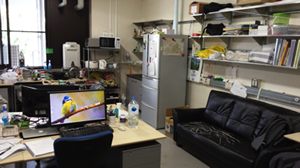
I believe, just like in American labs, Japanese labs value learning good methods, understanding science, and doing thorough, hard work. Nothing has led me to believe thus far that there is any difference in what is valued in a university research lab. I don’t think in my entire time here any one of my lab mates has been scolded or gotten in trouble. We have a really good relationship with one another, which I think goes to show how Japanese labs emphasize team collaboration just as much as any other lab, American or otherwise.
Then again, I’ve only had one month of experience working in one Japanese lab. I don’t even have that much experience doing research in America. It’s hard for me to say really what the differences between Japanese and American research groups truly are with such limited experience. Even more so, I think I would have to spend much more time in both environments to pick out which one is the best fit for me. From my experience so far, I’ve had a really good transition and have been able to do significant and meaningful work. I’ve learned a lot and developed new skills that I know will transfer to any future research endeavors I pursue.
Research Project Update
So, this week marked the beginning of testing my CNT FET samples. Over the mid-program meeting, my graduate mentor, Takushi, worked on creating the optical setup. He mounted the cryostat and installed the steering mirror that we are using to control the range that our laser can scan across the sample. In the beginning the week, we worked mainly on alignment, making sure that the laser is correctly fixed onto the sample at that the resolution of the scanned image is correct. Additionally, and perhaps most importantly, we have to align to make sure that the photoluminescence signal is collected by the detector. This has been the major challenge thus far in our project. We eventually want to take both current and photoluminescence as functions of gate-voltage, all the while checking the pressure-dependence as well. Being able to all of these different tests at once is the beauty of my project, and of the cryostat setup we’ve developed.
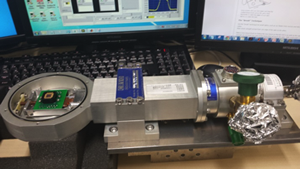
However, as I hinted earlier, it’s posed quite the challenge. Things haven’t nearly been as smooth sailing as the past few weeks, and I find myself in the lab later and later each day, trying to squeeze in more tests and attempting to fix the problems that we run into.
As of today, we’re still trying to figure out why our PL readings are very small in the cryostat setup, but are large in the in air, 3D stage setup that the lab already have. In the meantime, we have been able to collect current vs voltage measurements in air, and are now trying to get that data in the vacuum. We are able to do these measurements in situ as the pressure decreases, which is a really exciting prospect. Being able to pinpoint when exactly we see elimination in gate-induced hysteresis (if we see one) as a function of pressure will give us a greater understanding of the origin of the hysteresis and how to eliminate it in future devices.
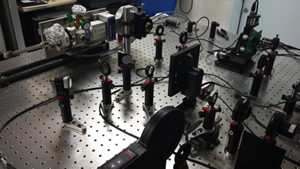
This coming week will be especially crucial for my project, as we’ll have the first data with pressure-dependence (the crux of this project)! Wish me luck!
For this week’s report, I interviewed my graduate mentor, Takushi, about the being a Japanese researcher and what he thinks about international research in comparison. Takushi is an Applied Physics PhD student in the Kato Group. He is a graduate of Kyoto University with a degree in physics.
Now for the questions…as a side note, I didn’t take verbatim answers, so they are all paraphrased.
Career background:
Why did you decide to study these fields?
Before he started college, he was interested in quantum information. As he learned more, his interests leaned towards semiconductor devices and optics. So, he pursued graduate study here with Kato group (the focus being nano optoelectronics).
What is it like to be a student in the US or Japan?
Takushi told me that college in Japan is fun, rewarding, and a little easy. There is very little homework and a lot a freedom with one’s time. He said that doing research is a little harder, as there is more pressure to get good results, but there is still a lot of freedom.
What is their career path?
Like many of us, Takushi isn’t sure what he wants to do after his PhD. However, unlike most people, he is considering going into something completely different than his studies: marketing. He told me he thinks that advertising and marketing is really interesting, and he might look into doing that as a career.
Labs:
What is the nature of their work environment?
The work environment is mostly relaxed, but deadlines put consistent pressure to get work done. He can choose when he wants to come in to work, but he knows that he has to get a lot of work done. It’s a balance between organizing one’s schedule and one’s workload.
How do they think that a lab in Japan differs from the US?
Takushi laughingly told me that he thinks there’s a lot more homework in the US (this is probably true). But, reasonably, he doesn’t have a clue from the similarities or differences, as he has never been there. He told me his image of the US research lab is similar to his own, especially because of the big US influence that Kato-sensei has.
International:
What is their international experience?
Takushi has no experience studying or doing research abroad; however, he has gone to several conferences outside of Japan, including one in Germany a few weeks back. He was able to learn more about the different setups and equipment used around the world.
How many international researchers work in the lab?
Right now, there are two of us (me and another student from the US). But, there have been several research interns that have come and gone since his working here. I’m the first one he’s worked with directly!
How has the internationalization of research impacted their work?
Takushi said it hasn’t impacted his work much, other than the great contributions the students gave to the lab as a whole and the fact that he has gained new friends from far off places. I feel flattered.
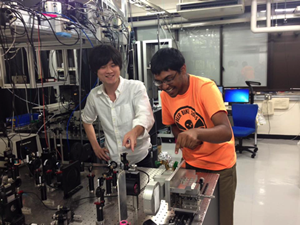
Takushi and I "doing science"
What are the most significant differences in the career paths of a researcher in Japan versus the US?
Although Takushi has a pretty unique career path, he let me know that most Japanese researchers work in companies after research, rather than academia. This I think is different than most PhD students in the US. I don’t have any numbers, but I think a lot more US grad students pursue academia positions rather than go into industry. Also, different approaches like starting up a company or working with non-profits are also popular in the US
Any questions for me about the US?
He asked me what I thought the differences were between Japan and the US, in terms of school. I told him he was right the money with the “more homework” thing. I also told him I felt at home here, and that there isn’t that much difference in terms of research life (at least in my experience). We both agreed that that is probably because of Kato-sensei, as he knows of the more traditional, hierarchical structure of other Japanese labs.
Research Project Update:
This last week has been particularly eventful in terms of my research project. We were able to see significant results in the form of an elimination of Gate-Voltage hysteresis for some devices in the IV measurement. However, we had some trouble finding the PL spectra for our CNT samples.
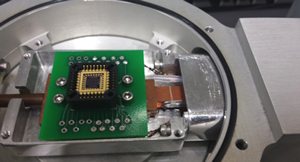
A picture of the sample mounted in the cryostat.
In order to solve this problem, we spent time troubleshooting the optical setup. We first checked to make sure the lens focused in correctly onto the sample. After that, we checked if we could see any PL at all, using an already working setup (one without the cryostat). After we saw PL in our samples in the working setup, we tried checking the samples without using the window on the cryostat. This proved to be the key breakthrough. We saw here that there was a slight misalignment due to the tilt of the cryostat and the dirtiness of the window. Unfortunately, I wasn’t able to hang around during the weekend to fix the issue, but Takushi was able to fix it and see PL spectra in our samples inside of the closed cryostat.
This development means that this next week we can take PL vs. Gate-Voltage measurements in a vacuum. It’s very easy to see the gate-voltage hysteresis in these measurements, and, if all goes well, we will be able to measure the pressure-dependence of the hysteresis.
We ran into a few hiccups with the electrical wiring this week as well, and I had to revisit my good friend, the soldering iron. Luckily, now that I’m an expert solder-er (a soldier of solid soldering, if you will), I was able to fix our issue with ease. I already feel like I’ve gained a lot of problem solving skills, just from troubleshooting problems that arise during our measurements. And it’s been incredibly rewarding to see good data come from it.
Hopefully, next week will be filled with even more exciting news!
This week’s report is focused on the topic of gender in Japan and the controversy of Haruko Obokata. In 2014, female Japanese researcher Haruko Obokata published a supposedly breakthrough paper on stem cell research in Nature. She was hailed an inspiration to all female Japanese scientists, as Japan’s scientific community is still very male-dominated. However, after several other labs attempted to recreate Obokata’s results to no avail, she was accused with scientific misconduct. It was revealed that some of the figures were fabricated and did not reflect the actual results of the paper, and eventually her research was retracted. Adding tragedy to this incident, Obokata’s mentor committed suicide amidst the controversy.
The escalation of this event is surprising to me, particularly with the fate of Obokata’s mentor. From my perspective, the consequences Obokata faced for being plagiarist and falsifying data were completely warranted. Although it sad that she appeared to be a role model for female scientists in Japan, holding everyone in science to the same, high standard is essential to all scientific progress. Japan, like the United States, is still struggling with gender equality. But, the worst thing one can do to help end the inequality is begin to cut corners on recognizing female accomplishment. And, along that line, holding people like Obokata to high standards is exactly what we need to do. Female scientists are slowly increasing in numbers here in Japan, and hopefully a new role model, a new breakthrough female researcher will emerge.
The condemnation of Obokata is the science community is something I can understand. The death of her mentor, Yoshiki Sasai, however, is incomprehensible to me. According to a Washington Post article, Sasai wrote that he was “deeply ashamed” of his co-authorship of the fraudulent papers before he killed himself. Earlier on during our orientation in Sanuki club, we had a discussion with the KIP students about cyber bullying in Japan and in the US, and the topic of suicide had come up. In Japan, suicide is met with a different attitude than in the US. Not only is it more common, but it is more “accepted” or met with less stigma. This may come from the historical significance of suicide in Japan being an honorable way to accept shame or death. To me, however, suicide is just as tragic as any other innocent death; no one should be put in a position where they feel it is okay to take their own life rather than live. So, the fact that this situation escalated to this brilliant researcher feeling as though he had to kill himself is shocking and incomprehensible.
Gender inequality has been very apparent in my stay as a research intern in Japan. My lab has no female students (much to the disappointment of my lab mates). And, although I see a few around, it is definitely noticeable that there are significantly more men in this research field than women. In 2014, Japan Times reported that only 14% of Japan’s scientists are women. Furthermore, this sort of inequality extends far beyond scientific research in Japan, as females are still disadvantaged by unequal employment and gender discrimination in education. However, recently, Prime Minister Shinzo Abe made equal opportunity and women empowerment a large part of his economic plan, dubbed “Abenomics.” I don’t think I’ve been in Japan long enough or interacted with enough people to understand the full dynamic of gender equality in Japan, but I hope that these steps made by the government can help bridge the current gap.
Research Project Update
This last week was full of exciting data collection and results. We were able to take successful tests on measuring photoluminescence vs. gate-voltage on two different samples. The results were good, as they showed an elimination of gate-voltage hysteresis in the samples at low pressure. We were also able to measure the time dependence of the recovery of the hysteresis after reintroducing the samples to air. Towards the end of the week, we experimented with putting the samples in a nitrogen environment, in order to isolate the cause of the hysteresis (which we think is due to water or oxygen gas in the air). The samples retained their hysteresis-less-ness in the nitrogen gas environment, which is good news for my project. I have pretty conclusive data that should be enough to construct a good poster for the upcoming SCI colloquia! The remainder of the week was dedicated towards determining the poster layout and starting to compile it all together. In addition, on my last day in the lab I’ll be presenting what I’ve done throughout my two months here. So, next week will be dedicated mostly to compiling my data and presentation. However, there is one more possible exciting measurement that we could do. There is a potential, now that we have a hysteresis free environment where we can dope the samples with a gate-voltage, to witness some really interesting band-structure phenomena in single carbon nanotubes. We’ll be checking next week if our samples are good enough to handle the measurements, and if so, we might be able to see this exciting phenomenon. I’m not going to go into detail about it right now, as I don’t know if we will be trying it yet, but, if we do, I’ll definitely write about it! That’s all for now; hopefully the poster comes out okay!
My stay in Japan is over. And I don’t think it’s hit me yet.
It’s hard to reflect on how my perceptions of Japan and the U.S. have changed, mostly because I’m still trying to comprehend that I won’t be waking up in Tokyo tomorrow morning, won’t be going to work at the Kato Lab, and won’t be meandering my way to a Freshness Burger for a late night bite (at least not for a while). But, I can definitely say that my perceptions of both the U.S. and Japan have changed. On the Japan side, I think I’ve lost my initial quasi-mystical intrigue I had with the country, which is both a good and bad thing. On one hand, that unrealistic expectation of technological awesomeness in major areas of Tokyo has been quite utterly shattered. However, I also have felt at home, have felt comfortable, knowing that my lifestyle Japan is a lot more similar to my way of life in America than I previously predicted.
My perception of America has also changed a bit since living in Tokyo. I have gained a huge sense of gratitude for the diversity of people and backgrounds that America hosts. It’s something that I think I’ve taken for granted and that I miss dearly. Despite the kindness and generosity of the Japanese people I’ve met, the society is so homogenous, and, at times, it’s very hard to be understood.
I feel like I’ve also changed a bit over these past three months. I’ve definitely become a bit more adventurous. I’ve become a lot more open to going out and exploring new places (where I might have otherwise relaxed in the comfort of my room). I think I’m also a lot more open to talking to strangers…especially when asking for help! Although in America, I’ll have Google at the ready in the palm of my hand, I still can use the skills I gained from “sumimasen-ing” random Japanese people to ask where a certain place is, or whether this food has meat in it, to help navigate my way through sticky situation. Lastly, I think I’ve become a lot more comfortable with living independently. I’ve managed a 40 hour work week with a commute, gone grocery shopping, and even did laundry consistently ( trust me, I’m even more surprised than you). It’s been an absolutely transformative experience here, one that I will surely miss.
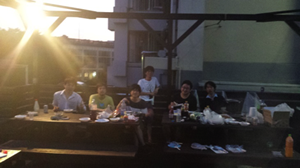
This week was also my last week in lab, and maybe my busiest one yet. The week began with finishing off some of the tests from last week that we ran over the weekend. After we collected that data, I was able to have a great meeting with both my mentor and sensei about planning my poster layout. The rest of the week was devoted towards compiling and analyzing my data into both the poster for SCI colloquium and for a presentation for Kato Group on my last day of the lab. The weekend before, my lab held a farewell cookout and I was given copious amounts of food and even a going-away present. Throughout the week, I took out my graduate mentor for dinner and had a final lunch with my lab mates on Friday. I presented to the group about the work I’ve done for the past 2 months, and *poof* my time in the group was over. As I was packing up my things and tying up some loose ends, I started to reminisce with my graduate mentor about some of the good times that were had. I hugged each of my lab mates good-bye (remember, these were a group of guys who were originally so devoid of physical contact that they didn’t know what a fist-bump was) and I headed off back to my apartment to pack for my final days. It was an amazing experience and I was able to leave on great terms with Kato-sensei and each and every one of my lab mates. They became some of my closest friends in Japan, and I will miss them as I head back to Houston.
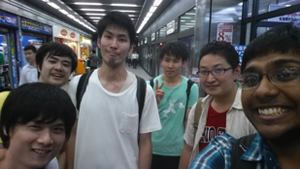
FINAL RESEARCH PROJECT OVERVIEW
Project Title: Eliminating Gate-Voltage Hysteresis in suspended Single-Wall Carbon Nanotube Field-Effect Transistors ![]()
Authors: Ajay Subramanian, Takushi Uda, and Y.K. Kato, Kato Group, Institute of Engineering Innovation
Introduction: Single-wall carbon nanotubes (SWCNTs) have an immense potential to revolutionized modern day electronics and optoelectronics due to their unique optical and electronic properties. Particularly, semiconducting SWCNTs have a direct band-gap, allowing one to take advantage of both optical and electronic properties in a device. One such device is the SWCNT field-effect transistor (FET). However, SWCNT FETs exhibit gate-voltage induced hysteresis and time-dependent behavior. This hysteresis, likely caused by atmospheric and environmental effects, prevents one from truly ascertaining the gate-dependence on multiple properties of the device. Our goal is to eliminate this hysteresis, figure out the conditions for doing so, and analyze the SWCNT FET devices without the hysteretic behavior.
Approach: we fabricated suspended SWCNT FET devices, performed photoluminescence excitation (PLE) spectroscopy, as well as creating a vacuum box (through modification of an optical microscopy cryostat) in order to measure the pressure-dependence of hysteresis of chirality-assigned SWCNTs.
Results: We observed an elimination of hysteresis in both current vs. gate-voltage and PL vs. gate-voltage in low-pressure environment. We also observed a gradual recovery of hysteresis after exposing the low-pressure samples to air. Finally, we isolated the cause of hysteresis to atmospheric molecule adsorption by analyzing the samples in a N2 environment and witnessing no hysteresis.
Discussion: By developing an easy-to-use and reproducible method of eliminating gate-induced hysteresis, we anticipate that these results can help us better explore crucial optoelectronic properties of SWCNT devices. In addition, we can now implement the vacuum box system setup in order to open up more potential low pressure testing for new devices.
Future Research: Immediately, we can observe new electric field or electrostatic doping effects on SWCNT devices and hopefully test some interesting theories, like giant band gap renormalization in single carbon nanotubes.
It’s been a few weeks now since we re-entered the United States from Japan. As each day goes by, I seem to remember another fond memory from Japan. But, at the same time, I’m so happy to be back with my friends and family in the U.S. It’s quite bittersweet.
Although some of my memories from Japan are very vivid, it’s still really difficult to answer the ever so popular question: “How was Japan?”
I mean, how are you supposed to answer that?!
But, I’ll try my hardest to put that question into perspective, and hopefully give some insight to what were the most valuable things I learned and experienced from my three months in Japan as a part of the NanoJapan IREU.
When speaking to a family member, Japan was an adventure in independence and culture. By far, the biggest thing I learned was how to live on my own. I lived in a modest sharehouse apartment and had to manage my day-to-day life on top of working a fairly consistent 9-5ish job. I managed a commute, cooking (or eating out…usually eating out), and laundry. And, above all, I was able to do all of these things successfully with the vast majority of people around me speaking a different language. I definitely feel confident now to go out into the world, maybe spend three months or more now living on my own, either in the U.S. or out. I was actually a little worried that, going into the program, I would have trouble living for three months on my own (I’d never traveled abroad before). But, after that first week having moved into the apartment, I knew that I would be okay.
Another big valuable lesson that I learned had to do with blending into a completely different culture. I’ve written quite a bit on this in previous weekly reports, but getting acclimated to a completely different society with such a unique culture is a difficult task, no matter who you are or what you’re background is. I probably made so many cultural gaffes during my stay in Japan, but I still feel like I was able to function in the society and be comfortable. Even if people were staring at me because of my gaijin-ness, I felt like I was able to overcome the cultural differences and successfully immerse myself into society.
When speaking to a professor, I would say the most important thing I learned in Japan was the ability to persevere and successfully do research on an international and independent level. There are very obvious challenges that a person has to overcome when attempting to study or do research in a foreign country. Not only does one have to face the challenges that you face in any lab (like learning and reading up on subject matter, handling equipment, meshing well with your lab mates, weekly presentations and reports), but there is also an added ‘international’ factor (things like language barriers, cultural differences, tradition, lab structure) that we have to adapt to. And, most of the time, these challenges would resurface again and again, even after perhaps being dealt with before. For example, the language barrier sometimes pops up after a whole week of being able to completely understand each other. Suddenly, someone (me, my graduate mentor, or other lab mates) wouldn’t understand a word or phrase that the other was using, and we would have to back track (with a dictionary) and try again. However, persevering through those challenges was an incredibly rewarding experience, as I was able to successfully complete my project and have a good relationship with all of the people I worked with. Additionally, the NanoJapan research internship felt a lot more independent (not surprisingly) than undergraduate research one might do throughout the year. I rarely had ‘busy work’ to do or menial tasks to undergo for the sake of my graduate student. I was given my own project with pretty much free reign on how to go about it. I still had a lot of guidance, both from my graduate mentor and from my PI, but it was mainly talking through potential solutions to problems and action plans. I was on my own most of the time to execute those solutions and plans. I think that that kind of independent work is very similar to the actual work graduate students do, which is valuable experience for the future.
To a potential employer, the most important thing I learned in Japan is how to adapt to an international work environment and think on my feet as to how to quickly solve challenges. Like I mentioned above, there is a certain number of unique challenges that an international work environment brings. Although I’ve already mentioned it (it was the most significant in my personal experience) the language barrier issue would be my go to example on how to quickly adapt. Although most of my lab mates knew English, not all of them were perfectly fluent. Especially in the first few days, this was a huge detriment to both my work in the lab, and also to building a relationship with my lab mates (something that is valued both by me, and hopefully by a potential employer). However, after navigating our way through some strange combination of broken English and Japanese, my lab mates and I were able to get on the same page fairly quickly. I remember, mostly in my first couple of weeks when I was working closely with my graduate student mentor, he would always have his computer nearby to go on to Weblio and do some English-Japanese translation. We both became very quick and picked up when the other didn’t understand an idea or a phrase. Through this mutual understanding, the language barrier issue slowly became a non-issue, and we became not only great working partners, but friends as well. Similarly, over time and after being able to quickly resolve language issues, I was able to develop a much deeper relationship with all of my lab mates. It’s worth noting here that it’s not the specific strategy of “have a dictionary handy” that I learned from this experience, but rather I learned how to make sure that issues like language shouldn’t be as big of a detriment as they can be to a productive work environment. Culture and international quirks are things that we can use to actually become stronger teams; they aren’t always just barriers to overcome.
Finally, if I were speaking to a student, the biggest thing I learned in Japan was becoming more open to new ideas and experiences (and new food). Now, I’ve never been a super-conservative-tries-nothing-new-always-in-comfort-zone kind of guy, but I’m typically not the person to go suggest the fun exciting things to go do. I like tagging along! Japan has taught me to tag along no more and to start taking initiative on experiencing new things. I never understood the value of trying new things until I went to Japan. The benefit is two-fold: first, the obvious, by trying new things you may find out you liked something that you previously wouldn’t have tried. Second, by going out and trying something new, or going out on an adventure with several unknowns, you’ll get to be exposed to a bunch new challenges, ideas, people who may completely alter the way you view the world. And I’m not exaggerating here. My idea on what the world is and who I am changed drastically after several different adventures in Japan. Taking a day trip to Yokohama, missing the last train in the middle of Shibuya, climbing Mt. Fuji, all of these experiences were things that I would have never thought about experiencing, but are now certainly defining moments of my transformative experience in Japan. When a friend asks me “How is Japan?” I immediately shoot off into one of my many stories that I’d formed through all of these adventures.
Looking ahead (now that I’m not actually in Tokyo), I think I will be looking into several new things to take part in. First of all, I am planning on taking Japanese classes here at Rice. I really enjoyed learning the language and I want to try to become proficient. Plus, I didn’t really do great job of learning how to read kana while I was in Japan, so I really want to be able to take another stab at it, perhaps in a more formal setting. Additionally, I’m trying to look into more international programs to apply to. I think NanoJapan was an excellent stepping stone experience that answered a lot of questions I had for myself (like whether I could live on my own, or learn a new language). I’ve gained a lot of confidence to try going abroad again. I’m not sure when I would do it or in what capacity, but I’m definitely considering it. Finally, as I think ahead to grad school, I’m seriously considering maybe doing some of it (if not all of it) in Japan. I know I want to go back to Tokyo, and grad school seems like a really good opportunity to do that. However, it’s a bit early for me to start thinking about what schools I want to apply to for graduate school (especially because I’m not sure if I even want to do graduate school). But, it’s on my radar!
I guess if I had still had one question about Japan it would be this: How do they keep it so clean?! Being back in Houston, there is always a little litter here or there…it’s getting kind of annoying. Especially because I know there’s a country out there doing it right!
Pre Departure Tips: The biggest mistake I made was not studying my kana enough. It is so helpful to be able to read at a basic level after the 3 week orientation, and the best way to do that is study study study before you leave.
Orientation Program Tips: Get sleep! It’s sometimes hard to get over jet lag, and sometimes harder to resist the temptation to hang out late night. But, sleep! At night. It will help so much.
Mid-Program Meeting Tips: The mid-program meeting might seem a bit scary, but the best thing you can do to prepare for the presentation is to really understand your project. Work hard and ask lots of questions at your lab. The presentation is very preliminary, so you don’t need to have completed your project or anything like that. Just make sure you have a basic understanding.
Working With your Research Lab Tips: Communicate! I had a pretty easy lab to immerse into, and I was able to communicate very freely to anyone in the lab. Not all Japanese labs are like that, so understand how communication flows through your lab (hierarchy and so on) and start using those channels to ask questions and get on track,
Living in your Research Host City: The subway is your best friend. If you ever get lost, ask for directions; people are super nice and will understand that you are gaijin and may need some extra help.
Language Study Tips: Practice a lot! Don’t stop talking once you get to your lab. Try your best to challenge yourself in the lab setting to use Japanese instead of English.
I really only have one other tip: be open to trying new things. Japan is a land of adventure and sometimes really weird stuff. But, you’ll never know if you like it until you try it!
Also, one gift giving tip: GET BLACK THUNDER. It’s the most amazing candy bar. It’s like a chocolate covered oreo. It’s amazing.